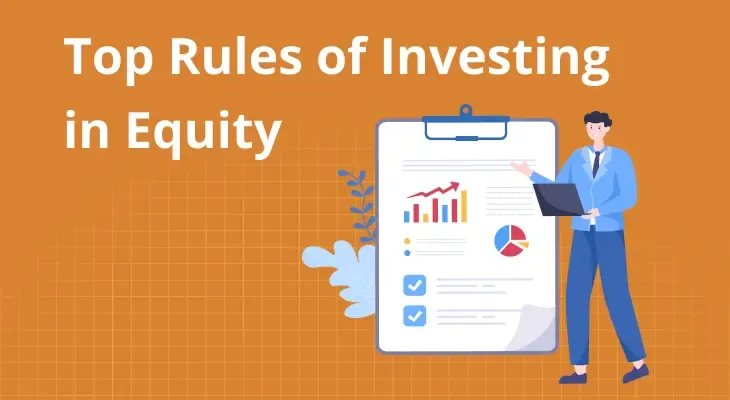
5 Important Thumb Rules for Investing
If you are a beginner to investing, you may not be sure about how to get started. There may be various questions holding you back, like how much you should invest, how to invest more, and how to save up for emergencies. Fortunately, there are various thumb rules that can make investing easier for you. Let’s take a closer look at some such useful rules that can guide you along your investment journey.
The Minimum 10% Investment Rule
This is one of the most fundamental investment thumb rules for beginners. It helps you start saving up for your future early on, so you do not lose out on valuable time.
As per this rule, you must begin investing at least 10% of your current salary in assets and schemes for the future. Thereafter, you need to increase the amount invested by 10% each year. This will help you progressively invest more as your income increases over the years.
The 100 Minus Age Rule
This is a fundamental rule of equity and debt investing. It helps you identify the ideal asset allocation for your portfolio. The rule is based on the principle that the risk tolerance of an investor decreases with age. So, if you are planning on investing in equity and debt, you can use the ‘100 Minus Age Rule’ to understand what percentage of your portfolio must belong to each of these asset classes.
According to this rule, you need to subtract your age from 100. The result is the percentage of equity investments you must have for your age. The remaining will, of course, be allocated to safer assets like bonds, debt instruments, deposits and the like.
For example, say you are 25 years of age. In that case, the asset allocation for your portfolio according to the ‘100 Minus Age Rule’ will be as follows:
Equity: 75% (100 - 25 years)
Debt: 25%
Similarly, for a 40-year-old investor, the asset allocation will be as follows:
Equity: 60% (100 - 40 years)
Debt: 40%
The Emergency Fund Rule
Before you move on to investing in equity and debt and add the best equity funds to your portfolio, you need to build a foundation to be prepared for any financial contingencies you may face. An emergency fund can help you with this. It is a set of investments that can be easily liquidated to meet the costs you may incur during an emergency, like an unexpected medical illness, an accident or a major home repair due to natural calamities.
According to the ‘Emergency Fund Rule,’ you should have funds amounting to at least 3 to 6 months’ worth of expenses set aside for contingencies. So, for instance, if you and your family spend around ₹40,000 per month on average, your emergency fund should be in the range of at least ₹1,20,000 to ₹2,40,000.
The Rule of 72
With the Rule of 72, you can get a clearer idea of the time it may take for your investments to double. According to this rule, if you divide 72 by the rate of return you expect from an investment, you can estimate the number of years it will take to double your corpus. The rate of return, however, must be compound interest.
For example, let’s say you are investing in equity and you expect a 12% return from your investments. So, according to the Rule of 72, the doubling time would be computed as follows:
Time taken to double your investment:
= 72 ÷ 12
= 6 years
You cn also use this method to compute the rate of return needed to double your investments within a specific period. For instance, if you want your corpus to grow twofold within 10 years, you must invest in an asset that offers returns as follows.
Expected rate of return to double your investments in 10 years:
= 72 ÷ 10
= 7.2% per annum
The Rule of 114
The Rule of 114 is similar to the Rule of 72. However, this rule helps you understand how long it will take for your investment to triple itself. Here too, the rate of return must be compound interest. You need to divide 114 by the expected rate of return to determine the period needed to triple your investment.
For example, if the rate of return you expect is 9% per annum, your investment may grow to thrice its value within the following time frame.
Time taken to triple your investment:
= 114 ÷ 9
= 12.67 years
Like the Rule of 72, this rule can also be used to compute the rate of return needed to triple your investments within a specific period. You simply need to divide 114 by the time period within which your investments need to grow threefold. The resultant rate of return is what you need to achieve this goal.
The Rule of 144
If you’re sensing a pattern here, you wouldn’t be wrong. The Rule of 144 can be used to compute the amount of time you need to allow your investments to quadruple. This rule is particularly useful if you are investing in high-risk, high-reward assets like the top equity mutual funds.
As expected, to arrive at the time required to grow your corpus four-fold, you must divide 144 by the rate of return expected. Let’s look at an example to understand this. Say you are investing in the best equity funds and you expect to earn returns at the rate of 12% per annum. In that case, here is how long it will take to grow your investments 4 times over.
Time taken to triple your investment:
= 144 ÷ 12
= 12 years
The 4% Withdrawal Rule
Even if you follow all the thumb rules outlined above and successfully manage to build a sizable retirement corpus, there is another risk that you should be prepared for — the risk of spending the corpus at a rapid pace. In other words, this is the risk that you may outlive your retirement corpus.
To avoid this, you can rely on the ‘4% Withdrawal Rule.’ As per this rule, it is advisable to limit your withdrawal to 4% of your retirement corpus annually. So, for example, if you have a retirement corpus of ₹2 crores, you need to manage your expenses in such a manner that your annual spending is limited to ₹8 lakhs.
Conclusion
The thumb rules discussed above can act as benchmarks and guidelines only. However, it is important to have an investment strategy and a financial plan that is tailored to your specific goals and requirements.
For instance, if you are a conservative investor, you may want to tweak the ‘100 Minus Age Rule’ and use an asset allocation that you are more comfortable with. Similarly, you may want to build a larger emergency fund if you are self-employed or if you have a significant amount of debt. The bottom line is that investing is a personal journey, and there is no one-size-fits-all solution. That said, these thumb rules can give you clarity if you are ever in doubt about what to do.

